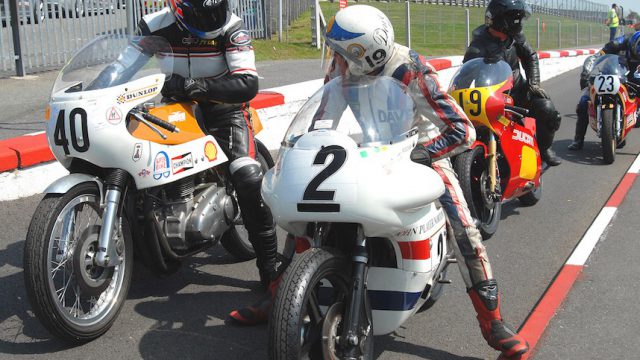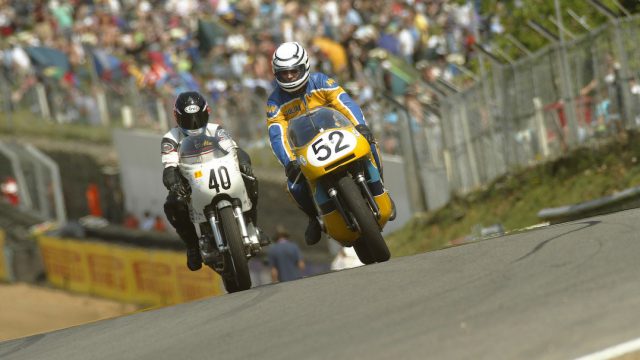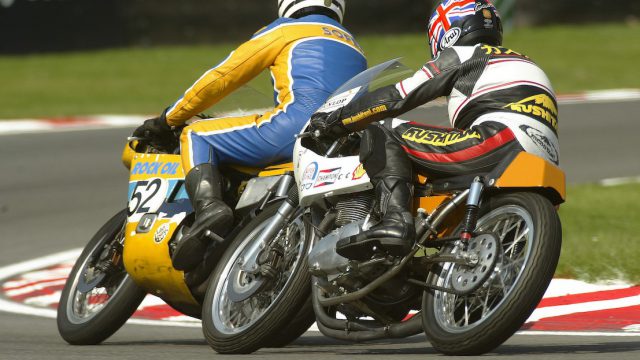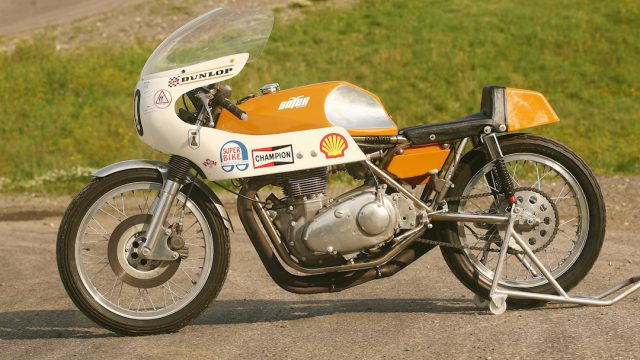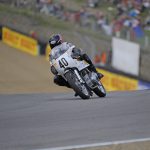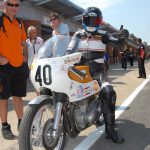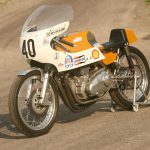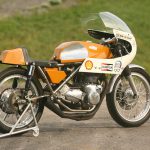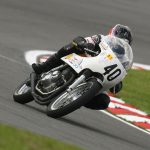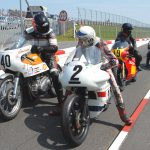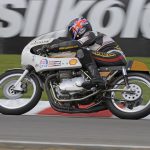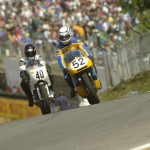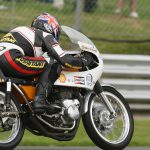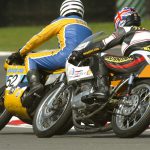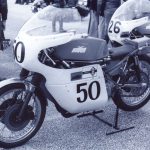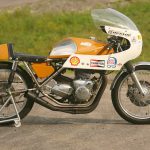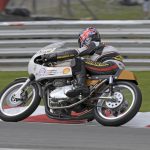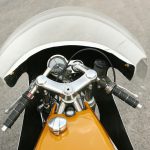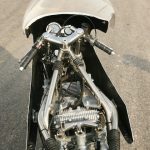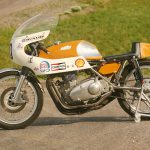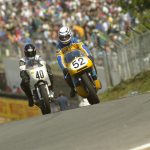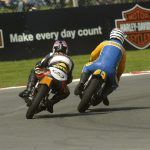Racer test at the Brands Hatch circuit where it spent much of its racing life of the 1972 Seeley-framed Boyer Triumph F750 triple, found in Australia and now restored as original
For a couple of seasons in the 1980s I raced in TT Formula 1 World Championship rounds at the Isle of Man, Vila Real, Assen and elsewhere aboard the ex-works Rob North-framed BSA-3 I’d discovered in Houston, Texas and then had P&M’s Richard Peckett restore for me. So this gave me some terms of reference in comparing the Seeley-framed Boyer Triumph-3 with the works triples, when the chance came to ride Mike Braid’s ex-Peter Butler bike in successive Historic parades over a BSB weekend on the full Brands Hatch GP circuit.
There couldn’t be a greater contrast between two motorcycles powered by the same engine. Whereas the Rob North bike was taller, tighter-fitting and quite short, the longer, lower, lighter Seeley-framed triple is more spacious, and thus more aerodynamic. That’s not only because of its lower build and reduced frontal area, but because it’s easier for riders of almost any height to tuck down behind the screen in a straight line, as I did along the Brands Hatch pit straight, with the glorious three-cylinder howl from the short 3-1 megaphone exhaust bouncing off the pitlane wall.
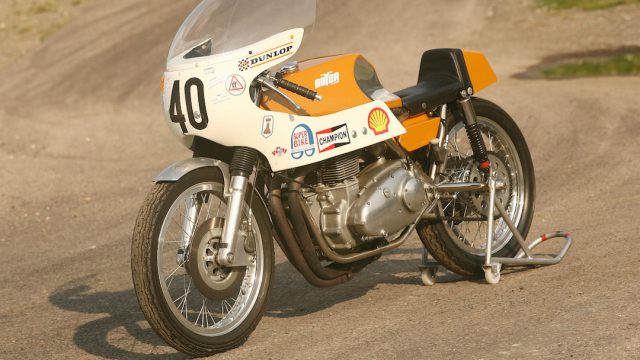
Yet despite the Boyer bike’s lower riding position, the footrests are also lower than on the North frame, without creating any ground clearance problems thanks to the 19-inch wheels, here shod with Dunlop’s benchmark period KR76 front/KR83 rear tyre combo. But the roomier riding stance didn’t make the Boyer bike in any way unwieldy, so that while the Seeley frame’s 1422 mm/56 in. wheelbase was pretty long by the standards of the time, and its 27-degree rake for the 34.5mm Seeley fork delivered quite conservative steering geometry, it seemed to change direction more easily, probably thanks to its lighter weight and lower cee of gee. This made it easy to flick from side to side through Dingle Dell, as well as stable over bumps in fast sweeping turns like Clearways. Best of both worlds – although it’s probably fair to say that the Rob North frame was designed for the Daytona bankings, whereas the Boyer Triumph is more at home on the British short circuits where it spent much of its life.
For the Seeley-framed triple’s key asset was its light weight of 157kg/346lb with oil, but no fuel, against the Rob North-framed equivalent’s 169kg/372lb, while a fully-equipped stock Triumph T150 scales 209kg/460lb. In pursuit of lower weight Boyer boss Stan Shenton had moved to a single front disc by the end of the ’72 season, in search of less unsprung weight and improved handling via a reduced gyroscopic effect on the steering. That made stopping the Boyer Triumph for Druids Hairpin at Brands, or into the tight, uphill turn at Surtees, pretty marginal with just the single 11-inch/280mm cast-iron Seeley disc with two-piston AP-Lockheed caliper, meaning you must also use its 9-inch/230mm rear companion very hard as well. That resulted in the rear end snaking around into the apex if I didn’t judge it correctly, and left it all a bit too late. But the otherwise measured, confident handling of the Seeley frame came to the rescue and brought everything under control again – no wonder the Ducati factory came knocking at Colin’s door soon after Boyer did in 1971, to ask him to rectify the wayward handling of their Daspa-framed 500GP desmo V-twin. History recounts that this is exactly what he did, resulting in the peerless handling of Paul Smart’s Imola 200-winning F750 desmo V-twin with its Seeley-inspired frame, and the Boyer Triumph’s capable steering, combining both agility and stability when each trait was needed, came from the same source.
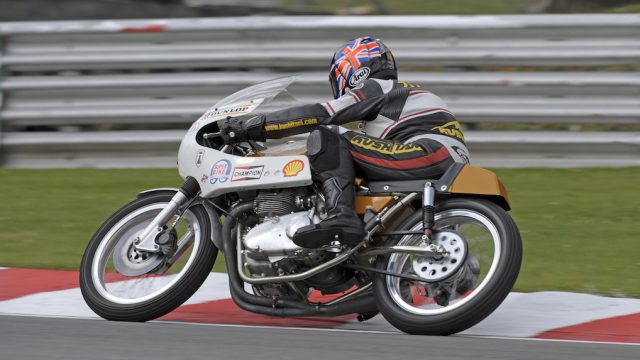
The Boyer-tuned engine had been rebuilt by Richard Peckett after having self-evidently led a very hard life in Australia – basically, it was worn out when Mike Braid discovered it Down Under in 2003, and rescued it from there in quite a poor condition with several non-period parts. But it still retains the same Piper-tuned Boyer head with large intake ports narrowing to a tighter exhaust. This results in a very peaky motor, which pulled OK from as low as 3,000 rpm out of Druids, only to fall off the pipe at around 4,500 revs when you must begin grappling with a pretty big hole in the powerband. You need to be careful clutching it back into its happy zone, as you might do with a British single equipped with a comparable megaphone exhaust, for fear of unhooking the rear Dunlop, but once you do coax it carefully above 6,500 rpm, you’ll be rewarded with a delicious surge of power from there until the 9,000 rpm redline. This engine has a much narrower powerband than I remember my flexible friend of a TT triple as having – but in return for that, this Boyer privateer Triumph-3 was a proven match for the works triples on British short circuits, as well as giving a good account of itself on the Isle of Man.
“We used the crankcases, cylinder head, rocker boxes and some of the engine castings from the original motor to build it back up again after returning it from Australia, together with Carrillo rods and a new crankshaft,” says Richard Peckett. “Back when Boyer built theirs, because of the lack of high compression pistons they skimmed a lot of metal off the block to raise the compression to 13:1, which was very high for the time – you couldn’t take much off the head, so you’d take a big lump off the block instead. But because we now have decent pistons, Mike and I decided to put another cylinder block on it, and chinned everything up so we could run standard high-compression pistons in it giving a lower 11.5:1 compression like we run on our Classic F750 racer today, but still with the original Boyer head.”

“Boyer’s tuning basically consisted of opening the inlet ports up huge, about 2mm more than we do, which meant they used to break into the oil drainways,” Richard continued. “We had a problem when we first ran it that one of those was leaking, so we had to do a repair on it. So, consequently that’s why you’re finding a lack of mid-range performance, because of their radical porting which makes it more of a top-ender. We used to run a slightly smaller port than the carburettor size, so you’ve got some ram effect, but Boyer would open it up to 30mm all the way through to the middle of the head, which means that you lose gas speed at lower revs, so therefore the bottom end performance suffers. Also, it’s got a very short megaphone exhaust on it which contributes to that, and the valve timing is slightly different to what was on the works bikes. The original Piper cam that was still in the bike when we got it from Australia was badly damaged, so I’ve fitted an American cam which Megacycle make for us – it’s one that I used to race in my own Triumph triple back in 1973. It’ll run with the standard radius tappets and it’s very similar to the works Triples’ cam profile, but just slightly softer. I suppose if we put larger carburettors on it than the 30mm Amal Concentrics we’ve fitted with Quaife trumpets as Boyer did, it might help give it a sort of ram air effect, but it is what it is – pretty peaky, I’m afraid, but that’s what they ran back then.”
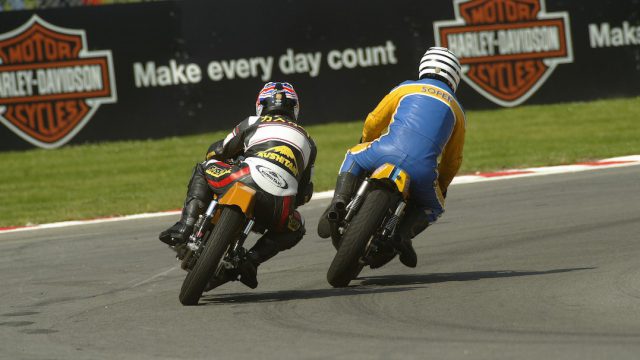
This means you must use the 5-speed Quaife close-ratio gearbox quite intensively, whose one-up right-foot change worked pretty well without using the clutch, delivering smooth, seamless gearshifts until it came to selecting top gear twice per lap on Brands gearing. After missing a couple of shifts I realised that you must use the clutch to hit fifth gear, and even then feed it in quite slowly and positively – probably the selector mechanism needed attention. But shifting at 9,000 rpm on the Smiths revcounter – with an oil pressure gauge to its right whose needle was parked at 80psi with the engine running, irrespective of revs – kept the needle above 6,500 rpm in each gear where it needed to be to avoid falling back into the patch of megaphonitis from 4,500 rpm upwards, which only started to clear around there. I have no idea why the tacho has a lower redline marked at 4,300 rpm – you need to run the engine much higher than that to get it carburetting properly. Keeping it revving up high allowed me to out-accelerate another famous Boyer-built bike that was on duty that day at Brands Hatch – the 1973 Hadleigh Honda four being ridden by the man that made it famous, Julian Soper. This is inevitably heavier than the Boyer Triumph triple, allowing me to get the jump on Julian out of Druids or Surtees.
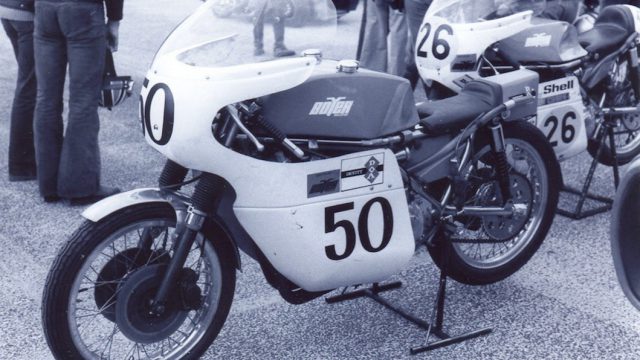
The Boyer Triumph-3 would have been a quite demanding bike to get the best from in the hurly-burly action of early-‘70s British short circuit racing, in which it raced exactly as I rode it at Brands Hatch, with the fairing lowers removed that were only fitted for longer, faster races like Imola or the TT. But the beauty of the Seeley frame is that it’s forgiving as well as stable, and I’m sure it was a key factor in making the Boyer Triumph triple as competitive as it was in 1972-73. Quite by chance, a couple of times I found myself lined up waiting to go out for another track outing at Brands Hatch alongside Dave Croxford aboard the John Player Norton Monocoque he graduated to in 1973, after two seasons aboard the similar Seeley-framed BSA-3 he rode for Colin Seeley. “Seeing you on that bike really rolls back the years!” exclaimed Dave the first time we saw each other. “I raced a Seeley Matchless for Colin in the 500cc class as well, but the BSA triple was my best ride – it had the same great handling as the single, but with twice the grunt. Mind you, it was only when I blew the triple up at Mallory in 1972 that I got to ride for John Player Norton. After that happened in practice, I went to pester [JPN team manager] Frank Perris for a bike. He agreed, and I only went out and won, beating Mick Grant and Phil Read on the other works Nortons. So after that it was goodbye to the BSA!”
But what a pity Stan Shenton never hung lights and a horn on one of his racebikes – it would have been the ultimate British café racer…!
* * * * *
Photo credit: Kel Edge
